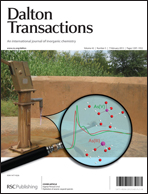The Re(I) complexes [Re(HPAN)(CO)3Cl], 1, and [Re2(PAN)2(CO)6]·C6H12, 2·C6H12, have been prepared by reacting [Re(CO)5Cl] with HPAN. Here (PAN)− is the deprotonated form of 1-(2-pyridylazo)-2-naphthol. A subsequent reaction of [Re(HPAN)(CO)3(CF3SO3)] with a chelating diphosphine ligand generates [Re(PAN)(CO)(P–P)]·CH2Cl2, 3·CH2Cl2. The structures of the complexes are determined by X-ray crystallography. The molecular structures observed in the solid state are retained in the solution (1H, 13C and 31P NMR and mass spectra). The photophysical and electrochemical properties are also investigated. The gas-phase geometry optimization and the electronic structures of [Re(HPAN)(CO)3Cl], [Re2(PAN)2(CO)6] and [Re(PAN)(CO)(P–P)] have been investigated with the framework of density functional theory. The absorption spectra of the complexes are calculated by time dependent density functional theory (TDDFT) using a conductor-like polarizable continuum model (CPCM). DFT calculation shows good agreement with the experimental ground state IR and NMR values. Excited state TDDFT calculations provide a better insight into the experimental luminescence spectra of all the complexes in solution.

You have access to this article
 Please wait while we load your content...
Something went wrong. Try again?
Please wait while we load your content...
Something went wrong. Try again?


 Please wait while we load your content...
Please wait while we load your content...